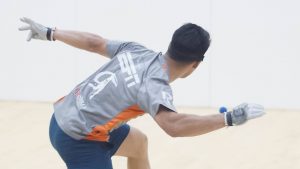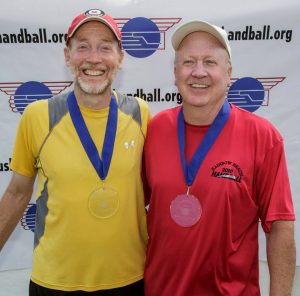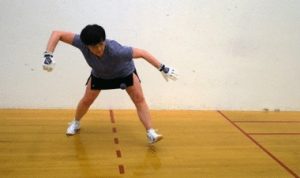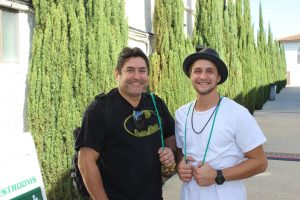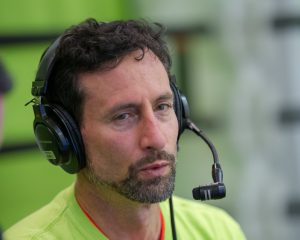 Dr. Dan Zimet, Sport Psychologist
Dr. Dan Zimet, Sport Psychologist
Do you have a question about the greatest game played with a ball? Send it to Dr. Zimet at MDHandball@hotmail.com. For more articles (and additional mental strategies) go to www.WPHLive.tv, menu option ‘Wrap Around’.
Wrap Around 11: Practice?
I’ve been playing the game for decades and confess that I’ve never practiced, unless you can call ‘warming up my hands’ practicing. I feel like playing is pretty much the same thing…but I’m curious to know whether practice is worth it.
The previous two hours of soccer practice, comprised of mind-numbing laps, sprints and drills, melted out of my mind when the coach yelled one magic word: “Scrimmage!!” With new found energy, I joined the rest of the team’s elation. We finally get to play! The mud and rain, until then a nagging annoyance, become a playground for puddle stomping, defensive slides and childlike amusement. Our coach just shook his head. I remember him throwing up his hands in defeat while we formed up teams for a meaningless contest.
If you don’t share memories like mine from a childhood in organized sport, it may sound familiar to your handball life. Nothing like a pick-up game for fun! Tournaments can be stressful, while working out and practicing shots can be chores we grudgingly endure.
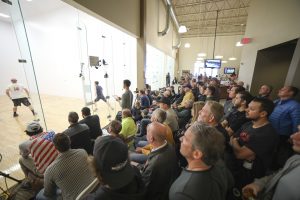 The time we spend playing handball
The time we spend playing handball
Practice can be defined as the performance of any activity or skill so as to acquire or sustain proficiency. As such, an athlete could potentially consider each of the four elements of sport, conditioning, drills, pick-up games and tournament play, as ‘practice’ provided the goal is, in fact, skill development.
You may want to take a moment to consider whether you actually engage in practice, and if so, how you distribute your time among the four categories. Interestingly, every sport is different and I’m not aware of a single scientific study on the most effective ratio to use. In this article I’ll be making the argument that practice, deliberate activity for skill development, is an essential ingredient to your handball game, while emphasizing the unique and critical role of drills.
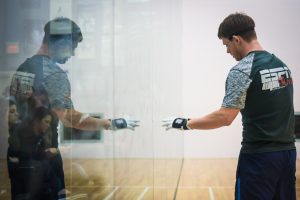 Practice: Conditioning, Drills, Pick-Up and Tournament
Practice: Conditioning, Drills, Pick-Up and Tournament
Conditioning is physical activity that prepares your body to endure the rigors of sport. Conditioning can include aerobic (e.g., running, cycling), anaerobic (e.g., weight lifting) and stretch/flexibility (e.g., yoga) exercises. The benefit of conditioning to sport performance is profound and includes increased self-confidence and mental resilience, greater overall strength, power, flexibility, and speed, delayed onset of fatigue, faster recovery, and decreased likelihood of injury. For all of these reasons, physical conditioning means a prolonged career in sport with greater overall satisfaction, motivation, and engagement.
Drills involve executing segments of the game under semi-structured conditions. Drills are the building blocks of practice, representing the smallest denominator in developing competency. Drills have numerous benefits, including changes in automaticity (e.g., performing without deliberate thought), improved decision making (what shot to use when), seeing how actions are related to each other (“if I do this, then that happens…”), improved execution and technique, improving feedback awareness (e.g., more accurate and precise interpretation of results), and gaining more accurate references on correcting errors (e.g., answering “what went wrong?”).
Pick-up games are an opportunity to compete without the stress that can accompany tournament play. For many, these games are all they want out handball because they’re challenging, a social activity between friends, great exercise, and a lot of fun. In terms of skill development, pick-up games offer a venue for practicing shots and experiencing the game in a competitive, but not too competitive, environment. For this reason, pick-up games are a great transitional opportunity where skills bridge to tournament play.
Tournaments are opportunities to put it all together. Here, we evaluate our complete game under the most competitive conditions. Tournaments are also opportunities to see a variety of styles of play to expand our own skill repertory.
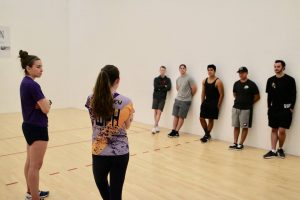 Drills: The building blocks of handball
Drills: The building blocks of handball
Novice Players: Coaches tend to agree that the primary reason to use drills with novice athletes is the development of minimal competency through the Retention Period of player development. Said another way: drills help athletes not quit in frustration. Take the bilateral nature of handball as an example. Often a source of pride for experienced players, it can become rapidly demoralizing for a novice. By isolating a skill, an athlete learns proper technique. This is particularly important for handball, where the best technique for striking the ball may not be immediately intuitive and failures to hit the ball correctly can cause hand pain/bruising from mishits. A novice athlete is less likely to become frustrated with drills for two reasons. First, a skill is far easier to perform when isolated. Second, there are fewer negative consequences to execution failure during a drill than during a game.
Drills also help novice athletes learn the mechanics, language, rules, and strategies of the game. By isolating skills, coaches can discuss the sport as a whole and the skill in specific. For example, learning an effective back-wall shot in 4-wall often requires a more experienced player to explain how to track and position yourself relative to the flight of the ball, and how to shift your weight back then forward while letting the ball drop into your strike zone. Through repetition of just the back-wall shot, an athlete develops the fluidity, confidence, cue-awareness and motor control needed to attempt the shot during a game. Additionally, an experienced player can discuss various strategies of which back-wall shot to attempt based on the various circumstances. This accelerates the learning process, which in turn promotes a positive experience.
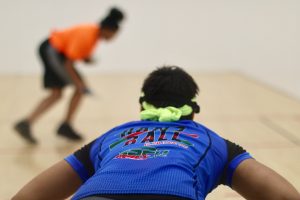 Experienced Players: One of my favorite quotes comes from Alcoholics Anonymous: “insanity is repeating the same mistakes and expecting different results.” Consider this statement: athletes tend to select the shot most likely to get the best result at that exact moment. Yet handball is a very complex game, requiring many different strokes and angles, many of which an athlete won’t spontaneously attempt during a game. After all, taking a new shot isn’t likely to produce better results than something an athlete has used effectively in the past.
Experienced Players: One of my favorite quotes comes from Alcoholics Anonymous: “insanity is repeating the same mistakes and expecting different results.” Consider this statement: athletes tend to select the shot most likely to get the best result at that exact moment. Yet handball is a very complex game, requiring many different strokes and angles, many of which an athlete won’t spontaneously attempt during a game. After all, taking a new shot isn’t likely to produce better results than something an athlete has used effectively in the past.
If an athlete only plays pick-up games, a range of habits will develop that will stifle or truncate progression over the course of a career. Why? Because the most effective shot you can hit as a novice won’t necessarily be the shot you’ll want to hit as an experienced player. But that’s what’s likely to happen without drills to gain proficiency and confidence with different choices. To illustrate, I’ll use an example from my own development. As a novice 1-waller, whenever the ball would come to my left-side the most effective shot I could hit was a flat-handed shoulder swing that floated the ball into the deep center of the court. I had not developed a fluid swing from that side and didn’t know how to hit a punch shot, so it was my best choice. My opponents were older athletes who might try to fly-kill the ball, but being young and aggressive I would rush to the front court for a retrieve. This choice kept the ball in play, and produced my personal best result at the time. When I moved indoors, the ball found its way to my left hand more often and my swing, which had served a utilitarian purpose in 1-wall, offered splendid opportunities for my opponents. Had I stuck with the same swing throughout my career, my skill progression would have been truncated. In my experience, most players are only as capable as their biggest weakness because more skilled players will capitalize on their flaws.
I needed more left-side options, but anyone who has tried to change a habit knows how hard this can be. Habits are like rolling boulders down a grassy slope. They leave a groove in our minds that draws behavior back into the same pattern, which further reinforces the habit. Creating a new habit involves grooving a new path as well as avoiding the previous, now unwanted, groove. Drills, which provide isolated and condensed opportunities to develop new habits, are ideal to this purpose.
Start with the end in mind by developing a specific goal for your development, then write that goal down. I suggest that you: 1) watch players who are more effective; 2) determine the weakest part of your game; 3) figure out what is realistic for you to accomplish; and, 4) get some coaching. Begin with the fundamentals, building off the basic strokes into situational shot making. For example, when I was developing my left-hand I started by working on a natural overhand throwing motion and built to hitting overhand ceiling balls from the deep left. You’ll particularly want to drill on fundamentals if, compared to others at your level, you are unable to effectively execute core strokes from both sides (e.g., punch, kill, drive, overhand, hop).
Once you have a written goal, create a structured regiment of three drills. Handball Magazine publishes articles with drills and you can always email the USHA or WPH if you want advice. Alternatively, you may want to create them yourself. On average, coaches look for three blocks of 6-10 iterations depending on skill demand (the more taxing the drill, the less iterations). If possible, think of a way to get feedback while working on the drills. Formal or informal coaching can, 1) direct our attention to important aspects of the skill; 2) demonstrate what to do or what we’re doing incorrectly; 3) help us know what to pay attention to; and 4) encourage greater motivation/adherence. Use video to watch yourself during practice and games as a way of getting feedback to avoid adding new bad habits. As your skills improve, add complexity to the drills. Then, integrate the skills into your pick-up games, and then tournament play. Before long, they’ll become second nature!
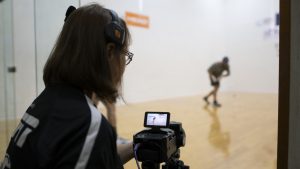 The good news about drills is that even a minimal amount of work helps. Called the Law of Practice, research shows that athletes get major benefits early in skill development with diminished returns later on. That means a little can go a long way.
The good news about drills is that even a minimal amount of work helps. Called the Law of Practice, research shows that athletes get major benefits early in skill development with diminished returns later on. That means a little can go a long way.
Drills might sound boring and, with rare exception, athletes tend to complain about conditioning and drills more than pick-up games or tournament play. I would argue that one of the best experiences in sport is doing something you were previously unable to accomplish, whether that’s hitting a new shot or winning more games off a rival. If getting better inspires you, think about where drills can fit into your weekly schedule. It’ll be worth your while!
Musings from the Masters
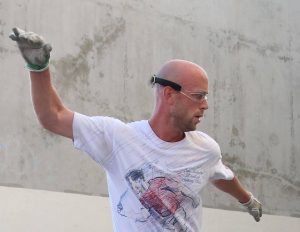 Sean Lenning, Tucson, AZ. b. 1985. Twenty National Open 3-wall titles (10 singles & 10 doubles), Worlds Open 1-wall title. Prefer to play outside
Sean Lenning, Tucson, AZ. b. 1985. Twenty National Open 3-wall titles (10 singles & 10 doubles), Worlds Open 1-wall title. Prefer to play outside
If you’re dripping sweat and breathing heavily at the end of a practice session, you’re doing something worthwhile. Unless you’re practicing your serve, merely bouncing the ball and hitting it is called warming up– not practice. Rallying with yourself is one of the best workouts I can imagine and is a great way to work on a few things. Getting behind the ball and stepping into each shot should be the main priority, but also have a few specific shots that you want to focus on. Keep in mind that in order to change something about your game, you have to do the extreme opposite of what you’re currently doing. Making incremental adjustments doesn’t work because you’ll stop making changes before you’ve discovered all of your capabilities. There is also a strong likelihood that you’re not changing anything at all and only think you are– a great way to plateau. You have to explore the full spectrum of possibilities and then work backward from there. For example, if you’re trying to be more patient on your backwall shots, then let the ball drop as low as possible (one or two inches) before you strike it. Eventually you can bring it back up to where it’s most comfortable and effective for you, but maybe you’ll find that you’re rolling it out when you take it very low like a Dan Armijo or David Chapman. On the other hand, if you don’t go to that extreme you’ll just never find out. Or maybe you’re trying to improve your off-hand. In that case, you just have to let loose and try all kinds of things in an attempt to find the perfect synchronization of your elbow and wrist. If your off-hand is garbage, then minor adjustments won’t do a thing. You can develop a defensive and safe off-hand that way, but not a weapon. Sure, you’ll be hitting the ball every which way as you practice and search for the right timing, but that’s good; at least you’re actively searching and not just refining your bad habits. I still remember the day that my left came alive through practice. Even just a few minutes before it finally clicked, I was hitting the ball straight into sidewalls, spiking it, and occasionally whiffing it completely. I ultimately figured it out because I wasn’t afraid to try something drastically different and out of my comfort zone. That’s the realm in which you’ll find the value of practice.
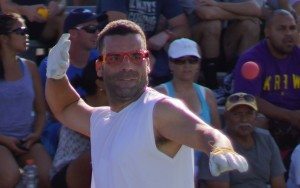 Cesar Sala, Bronx NY. b 1977. Six National Open 1-wall titles (2 singles & 4 doubles), 1 Worlds Singles small ball. Prefers 1-wall small ball.
Cesar Sala, Bronx NY. b 1977. Six National Open 1-wall titles (2 singles & 4 doubles), 1 Worlds Singles small ball. Prefers 1-wall small ball.
Everything is practice and practice is everything. Even warming up is a form of practice. We all have rituals, habits and all types of behaviors that lead up to our final product on the court. Some of those practices are deliberate and others aren’t. Regardless of your routine, you’re practicing.
For me, practice plays an important part in maintaining my game as well as improving it. At the early stages of playing I had to hit the ball repeatedly in order to develop my body and form. I remember working on 2 drills that were very basic to help my development. I swung overhand and then underhand. Ruby Obert demonstrated these drills while explaining the importance of practice. He was able to do it with either hand without moving from that spot on one foot! So I worked on it with my strong hand then when I was able to do 100 without missing I moved on to my off hand. I didn’t stop until I reached 100 again. Those drills alone increased my strength, arm stamina and accuracy. They also tested my patience. It’s tough to get to 99 and miss only to start over again! Once I passed those tests I moved on to the next practice. Each practice became a little more difficult and had a purpose. Practice became a game in itself. The beauty of it was that there was always another challenge waiting for me regardless of what I mastered along the way.
Sometimes the challenge is remastering something you forgot or unlearning something that has lost its value or is possibly a bad habit. Developing these strong fundamentals help me perform at my best even when I don’t play often. A strong foundation allows a player to propel whatever strengths and natural abilities they may possess to the next level. Over time the practices become more about sharpening those skills allowing the player to implement specific strategies to be applied in competitions.
Carl Obert was more of a drill instructor who could really break the game down to the littlest detail. He could break down the game and it’s players like no one I’ve ever met. Whenever Carl would get on me about practice he reminded me of Mickey from Rocky. He has an old school no retreat no surrender way about him. It’s something to appreciate for sure. For me, I’ve always found solace in the basics that Ruby showed me.
Whenever I take long layoffs from the game I’m able to go back to the basics before playing and it eases my transition back into the game I love. In some ways, practice has a greater value than the game itself!
Dave Dohman, Munster, IN. b 1956, Handball Hall of Fame, 2009. Nine National Open 3-Wall Doubles titles, 24 National Masters titles. Prefers 3-wall
I don’t practice anymore; last time I remember was coming off knee replacement almost 4 years ago when I went back to basic drills I learned over the years [mainly at LFC]. Those drills consisted of a repertoire of all basic shots. Kill, open-hand ceiling, back wall, pass, wrap around and fist shots to the ceiling using 2 or 3 handballs. I found it boring to spend any more than 20-30 minutes practicing but its merits absolutely payed off. I would recommend similar drills to any beginner or intermediate player for sure. Most higher level players can get similar benefits from game situations but ANY additional time on the court will always improve level of play.
Another option I have tried is the “practice” game where you concentrate on a specific shot during every rally or for the duration of a game. Try winning a game without any attempted kill shots. Be creative in what you practice so as not to get bored or concerned with winning or losing.
NBA Hall of Famer Larry Bird was rumored to have practiced multiple basketball shots until he could hit the exact same shot 10 times in a row. No wonder he was so good.
Vern Roberts Jr., Tucson, AZ. b 1954. Handball Hall of Fame, induction 2002. Preferred to play outside (prior to replacement parts
Practice is always worth it, and especially when developing a new stroke or shot. Learning and re-learning how to step into a back wall shot, punching the ball to the ceiling, steering or keeping your serve down, are all things that require regular attention. Let’s face it, we’re all a bit lazy and we all think we know where the ball will end up off the back wall, so why move all the way back and take two or three extra steps? The answer is easy when you see what happens when you don’t take the extra steps and the ball doesn’t “go anywhere.”
Lifting your serve, so it comes off the back wall in four-wall? That means you’re likely lifting your weight and thus the ball. Staying down on your serve and the follow through is great training to stay down on your killshots, too.
LeaAnn Martin, Bellingham, WA., b. 1956, Handball Hall of Fame (2010), 20+ National and World titles in singles and doubles, played 4 wall.
Practice is VERY VALUABLE! I can honestly say when I was competing at a high level, I spent much more time practicing than playing. There are three very basic and simplified ways to look at the benefits of practice.
First, just look at the top athletes in the world. Do they spend all their time playing? They spend significant amounts of time practicing, drilling, and conditioning. They have hours of time training each day, and it is not spent just in scrimmage. Time is devoted to skill fundamentals in drills. Take any athlete at a high level — professional, Olympic, etc. – and you will find that all training time is not spent in scrimmage or game play. I played volleyball in college and I would estimate that 75 to 90% of our practices/training times were spent in drills and skill practice. Think of professional football or basketball players and all the time spent in drills. Top athletes understand the value of practice.
Why is so much time spent practicing? This leads to the second basic way to consider practice vs. game play. If I need to work on my overhand left to hit a ceiling shot, I could spend 30 minutes in the court playing and the situation in which I need to use that shot might come up a dozen times (depending on, of course, who I’m playing). In other words, I would have perhaps a dozen times to practice that shot that I need to improve. Or, I could get in the court and throw the ball to my overhand left over and over. Better yet, I could have someone else throw the ball to me. How many times would I get to practice that in 30 minutes? It’s easy to see the difference. For simplicity sake, let’s say it takes about 500 practice trials to learn a shot. I will certainly get 500 practice trials faster in a practice situation than in game play.
Thirdly, we can look at basic principles of learning. In general, we learn by performing a new skill in a simple “environment,” meaning there are not a lot of variables (e.g., position of the opponent, how the ball is coming to you, the score of the game, your position in the court) with which to deal. The learner has the best chance of success (hitting the ball correctly) when the variables are eliminated or minimized when learning. As the learner becomes more proficient, the variables can be introduced. In other words, the environment becomes more and more complex in small steps. This is referred to as “progression.” Think of learning how to kick a ball in a soccer game. The first progression for a learner is to stand stationary and kick a stationary ball. When this is mastered, the learner can practice taking a few steps before kicking a stationary ball. This is followed by taking some step to kick a moving ball. Gradually, adding more variables such as faster movement, receiving the ball from a pass, kicking/dribbling the ball with a defender, etc. Using the skill in a game (particularly if it a competitive situation) is the most complex environment that exists. If we think of learning how to hit a fist ball to the ceiling in handball, why would we even try to learn or introduce that skill in a game? It doesn’t make pedagogical sense. And, logical progressions help insure that skills are learned correctly. So, it’s not necessarily that “practice makes perfect.” As my research mentor says, “perfect practice makes perfect.”
My apologies for the lengthy response, but it is a subject near and dear to my heart. I have taught college students how to become physical educators (by teaching them how to teach movement skills) for three decades. I can’t help but be passionate (and wordy) about it
Missing the ceiling when you’re trying to hit ceiling shots? That means it’s time to review your point of contact, the lift in your legs on your punch and then the leaning back on your overhand (just as you’d throw the ball to the ceiling).
All these (and more) are things that would indeed help by “going back to the drawing board,” to retrain your body and mind. Practicing them so that they become natural instincts will have you performing the same motions and steps in the course of a game.
Once the fundamentals are back in a groove, you can practice while playing a game, i.e., playing a righty as if he or she is a lefty, hitting all passing shots, etc., which can also prove to be beneficial.
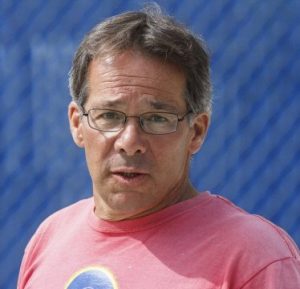 Albert Apuzzi, Brooklyn NY. B. 1955. Handball Hall of Fame, Twenty National Open 1-wall titles, 32-time Open finalist. Prefers 1-wall small ball.
Albert Apuzzi, Brooklyn NY. B. 1955. Handball Hall of Fame, Twenty National Open 1-wall titles, 32-time Open finalist. Prefers 1-wall small ball.
I believe that practice makes perfect. I also believe that after initially practicing a skill alone or coming up with a new game plan it needs to be used in on court situations. Once you have mastered the mechanics most progress will be mental. Simply a matter of identifying strengths, weaknesses, patterns, tells & strategies. Once this has been accomplished you should be able to immediately make adjustments.
“Feeding” yourself is only useful up to a certain point. I personally preferred practicing during game situations because your opponent is trying not to set you up & it’s more like the environment you will be performing in during a tournament.
I mostly played outdoors. If you practice alone you risk chasing the ball most of the time. My practice sessions were almost exclusively in game situations. However, we would make handicap games. Some common ones are left to two (one players weak hand to his opponent’s both hands), lob serves only, overhand serves only, singles doubles (one player vs 2 opponents), over the short line with lob serves, short games (ex a 3 point game to get used to pressure situations), spot points (start your opponent with ex. 10 points). Eric Klarman got fat on Blimpies spotting me points in 4-wall & much to his surprise I gladly returned the favor on a 1-wall court.
One more game was that the server would automatically loose the volley if he/she couldn’t end it by the 3rd time he hit the ball
John Robles, Phelan CA. b1965. Highest professional ranking USHA #3. 15 National Masters titles, 4 Worlds titles, 1 Canadian Master Title, Southern California Hall of Fame. Prefers indoors (but I also love outdoors)
I’ve been playing the game for decades, training for decades and practicing for decades. I’ve also won for decades…. goes hand in hand.
Do you have a question about the greatest game played with a ball?
Send it to Dr. Zimet at MDHandball@hotmail.com.
For more articles (and additional mental strategies) go to www.WPHLive.tv, menu option ‘Wrap Around’.










